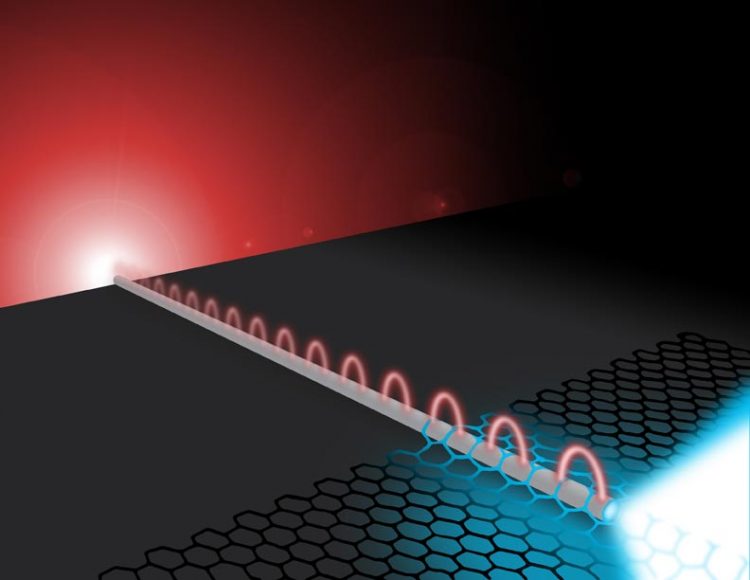Atomically Thin Material Gets Excited From Afar, Opening a Door for Integrated Nanophotonic Circuits

Illustration by Michael Osadciw, Creative Services, University of Rochester Far-field photons excite silver nanowire plasmons. The wire plasmons propagate to the wire's distal end where they efficiently interact with the two-dimensional material semiconductor molybdenum disulfide (MoS2). The plasmons are absorbed in the MoS2 creating excitons that subsequently decay converting back into propagating photons.
Reporting today in The Optical Society’s (OSA) high-impact journal Optica, optical and material scientists at the University of Rochester and Swiss Federal Institute of Technology in Zurich describe a basic model circuit consisting of a silver nanowire and a single-layer flake of molybdenum disulfide (MoS2).
Using a laser to excite electromagnetic waves called plasmons at the surface of the wire, the researchers found that the MoS2 flake at the far end of the wire generated strong light emission. Going in the other direction, as the excited electrons relaxed, they were collected by the wire and converted back into plasmons, which emitted light of the same wavelength.
“We have found that there is pronounced nanoscale light-matter interaction between plasmons and atomically thin material that can be exploited for nanophotonic integrated circuits,” said Nick Vamivakas, assistant professor of quantum optics and quantum physics at the University of Rochester and senior author of the paper.
Typically about a third of the remaining energy would be lost for every few microns (millionths of a meter) the plasmons traveled along the wire, explained Kenneth Goodfellow, a graduate student at Rochester’s Institute of Optics and lead author of the Optica paper.
“It was surprising to see that enough energy was left after the round-trip,” said Goodfellow.
Photonic devices can be much faster than electronic ones, but they are bulkier because devices that focus light cannot be miniaturized nearly as well as electronic circuits, said Goodfellow. The new results hold promise for guiding the transmission of light, and maintaining the intensity of the signal, in very small dimensions.
Ever since the discovery of graphene, a single layer of carbon that can be extracted from graphite with adhesive tape, scientists have been rapidly exploring the world of two-dimensional materials. These materials have unique properties not seen in their bulk form.
Like graphene, MoS2 is made up of layers that are weakly bonded to each other, so they can be easily separated. In bulk MoS2, electrons and photons interact as they would in traditional semiconductors like silicon and gallium arsenide. As MoS2 is reduced to thinner and thinner layers, the transfer of energy between electrons and photons becomes more efficient.
The key to MoS2’s desirable photonic properties is in the structure of its energy band gap. As the material’s layer count decreases, it transitions from an indirect to direct band gap, which allows electrons to easily move between energy bands by releasing photons. Graphene is inefficient at light emission because it has no band gap.
Combining electronics and photonics on the same integrated circuits could drastically improve the performance and efficiency of mobile technology. The researchers say the next step is to demonstrate their primitive circuit with light emitting diodes.
Paper: K. Goodfellow, R. Beams, C. Chakraborty, L. Novotny, A.N. Vamivakas “Integrated nanophotonics based on nanowire plasmons and atomically-thin material” Optica Vol. 1, Issue 3, pp.149-152 (2014).
About the University of Rochester
The University of Rochester (www.rochester.edu) is one of the nation’s leading private universities. Located in Rochester, N.Y., the University gives students exceptional opportunities for interdisciplinary study and close collaboration with faculty through its unique cluster-based curriculum. Its College, School of Arts and Sciences, and Hajim School of Engineering and Applied Sciences are complemented by its Eastman School of Music, Simon School of Business, Warner School of Education, Laboratory for Laser Energetics, School of Medicine and Dentistry, School of Nursing, Eastman Institute for Oral Health, and the Memorial Art Gallery.
Contact Information
David Barnstone
dbarnsto@ur.rochester.edu
585.276.6264
Media Contact
All latest news from the category: Physics and Astronomy
This area deals with the fundamental laws and building blocks of nature and how they interact, the properties and the behavior of matter, and research into space and time and their structures.
innovations-report provides in-depth reports and articles on subjects such as astrophysics, laser technologies, nuclear, quantum, particle and solid-state physics, nanotechnologies, planetary research and findings (Mars, Venus) and developments related to the Hubble Telescope.
Newest articles

Bringing bio-inspired robots to life
Nebraska researcher Eric Markvicka gets NSF CAREER Award to pursue manufacture of novel materials for soft robotics and stretchable electronics. Engineers are increasingly eager to develop robots that mimic the…

Bella moths use poison to attract mates
Scientists are closer to finding out how. Pyrrolizidine alkaloids are as bitter and toxic as they are hard to pronounce. They’re produced by several different types of plants and are…

AI tool creates ‘synthetic’ images of cells
…for enhanced microscopy analysis. Observing individual cells through microscopes can reveal a range of important cell biological phenomena that frequently play a role in human diseases, but the process of…





















